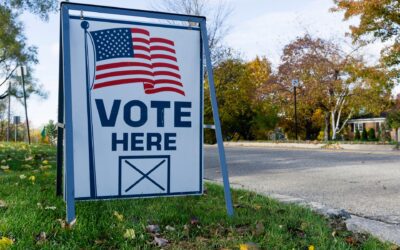On the eve of the first major presidential debate, the latest likely voter survey of the battleground states on behalf of Women’s Voices. Women Vote Action Fund shows Hillary Clinton settled into a strong lead in Pennsylvania, a modest one in North Carolina, and essentially tied in Ohio and Nevada.[1] Her overall margin has narrowed from where we had it across the battleground in June. Nothing comes easily in this election year, but the Clinton margin should grow from the structure of the race revealed in this analysis. In the two-person ballot, her margin grows 2-points to a 5-point lead across these states and she takes the lead in Nevada. And if the 3rd party candidates weaken, as is normal, Clinton disproportionately benefits.

The structure of the race
This survey shows why the presidential race in the battleground has tightened, but also why it is likely to widen back up. Trump’s better margins come from some consolidation of base Republicans and Clinton has lost support to 3rd party candidates in the wake of the campaign’s travails. Trump continues to earn overwhelming and intense support with white working class men who are making themselves the backbone of the Republican presidential coalition. Over three-quarters of white non-college men say the country is on the wrong track, making them the most pessimistic voters in the country. And 63 percent are casting a ballot for Trump, as they make disappointment known. But as we shall see, even extraordinary turnout from these voters cannot tip the Clinton states to Trump.
Clinton still wins the Electoral College majority, however, because of her stable support with parts of the Rising American Electorate and her inroads with other swing groups. The unmarried woman and minorities at the heart of the RAE are voting for Clinton in force. Three-quarters of minorities are voting for Clinton in these battleground states, she is getting 62 percent with unmarried women and is even winning the majority of white unmarried women (52 Clinton to 31 percent for Trump). Right now, unmarried women are showing respectable levels of voter engagement. In this poll, unmarried women and Democrats fall just 2-3 points below Republicans in saying this election matters tremendously.

But Clinton is also over-performing with college graduates, suburban voters and the white working class women who are put off by Trump. That is a big part of the story.

Donald Trump’s vote, on the other hand, is driven primarily by the white working class men who are making themselves the backbone of the Republican presidential coalition; they are 30 percent of the Trump vote. But in this new America, they would have to increase their share of the vote from 15 to 24 percent in North Carolina, 15 to 18 percent in Nevada, and 20 to 31 percent in Pennsylvania, all else being equal, to put Trump ahead in those states.
Incomplete partisan consolidation
The incomplete consolidation of Democratic partisans for Clinton and the weak consolidation of Clinton voters for Senate and House candidates are the main reason Democrats down-ballot are falling short of their potential at this point. Clinton is getting 87 percent of Democrats, short of the 92 percent Obama had in these states in 2012. She only gets 78 percent of Obama voters and 79 percent of those who approve of Obama.
Clinton will likely benefit disproportionately if the race becomes more polarized. In the two-way ballot she gets 93 percent of Democratic voters. So, she clearly has the potential to drive up her margin with partisans.
Trump does not have such an opportunity. He currently gets 82 percent of Republicans, certainly up from our earlier surveys. However, his vote in the two-way ballot leaves him at just 86 percent of the vote in the GOP base. There are 14 percent in the Republican Party who just won’t vote for him. Those holdouts are concentrated among the moderate Republicans where he is getting only 60 percent of the vote.[2] One-quarter are voting for a 3rd party candidate (21 percent for Johnson) and 10 percent are casting ballots for Clinton. Furthermore, there is a halo effect for Clinton, who enjoys a 57 percent recall among Democratic primary voters, but not for Trump among Republicans. He is topped out within his base.
Potential Democratic consolidation creates this campaign’s target groups
The starting target is the 18 percent of the Democratic and Democratic leaning voters who are holding back from Hillary Clinton. These target Democrats are change voters: three-quarters say the country is on the wrong path. Well over 60 percent have unfavorable views of both Clinton and Trump, though they feel very positively about President Obama.
Millennials are at the center of the story. They comprise nearly four-in-ten of these unconsolidated Democrats. They form a parallel story to the disaffected white working class men. Millennials want change, and 61 percent say this country is off on the wrong track. They are in an anti-establishment mood, and 31 percent of millennials are now not voting for a major party candidate. Clinton is only getting 40 percent of the millennial vote in a 4-way ballot. She is particularly struggling with the white millennials where she is running even with Trump – 34 Clinton to 33 Trump, with one-third voting for 3rd party candidates.
Consolidating Democrats and winning races
The incomplete consolidation of the Democratic Party at the top of the ballot is exaggerated down-ballot, and that creates a huge opportunity. That will also impact what messages can really move the vote. Only 62 percent of Democrats and Democratic leaning independents are voting for the Democratic Senate candidate. That means that there is a big bloc of 15 percent of the electorate in these states who are voting for Clinton but not Democrats in these key federal races.
Clinton widening her lead and winning states and Democrats making gains in the Senate and House depends on the right strategy and messages for reaching these voters. We tested one on GOP extremism, one linking Republican candidates to Trump and one offering a positive Democratic economic message.
Democrats, millennials and Democratic target voters are desperate to hear where the Democratic candidates want to lead the country. The message that consolidates Democrats more than any other tested in this survey is one that offers a clear positive economic agenda. It says that Democrats have a plan for the economy, and that to get these things done, we need a Democratic majority in Congress.

A big majority of 61 percent found this to be a convincing reason to vote for the Democratic candidate for Senate, 29 percent said it was very convincing. But it was particularly well-received by the Democratic target groups that need to be consolidated. Over half of them said it was a very convincing reason to vote for the Democratic candidates.
An attack on Republican candidates for being associated with Trump as their party’s nominee is not as successful. It gets a strong response, but it is weakened by the fact that a plurality of voters think the GOP is divided and many candidates in his own party do not support him. Also, it simply does not lead to people consolidating their vote behind Democrats.

But it is clear that the greatest gains down-ballot, and at the top of the ticket, come when voters hear the Democrats offer a positive vision for where they will take the country and how they will change an economy that only enriches the few. It puts them on the side of change and a better future.

Conclusion
The race has tightened but Hillary Clinton is leading in the presidential battleground due to her strong support from unmarried women, minorities, and swing groups turned off by Donald Trump. There is still room for the Democrats to consolidate, however, both at the top of the ticket and down-ballot. Democratic targets for consolidation are eager to hear more about what Democratic candidates will do if elected. A message that argues for a Democrat majority to execute a progressive economic agenda moves unconsolidated Democrats to vote for their party candidate, both at the top of the ticket and down-ballot.
[1] On behalf of Women’s Voices. Women Vote Action Fund, Democracy Corps and Greenberg Quinlan Rosner fielded this survey of 1,600 likely voters across 4 competitive battleground states on September 10-19, 2016. Respondents were divided equally among states (n=400) of North Carolina, Nevada, Ohio, and Pennsylvania. The states were weighted proportional to their vote share. Fifty one percent of respondents were reached by cell phone, in order to account for ever-changing demographics and accurately sample the full electorate in each state. Margin of error for the full sample = +/-2.45 percentage points at 95% confidence. Margin of error for each state sample= +/-4.90 percentage points at 95% confidence.
[2] Republicans who say they are liberal or moderate on ideology. They are more than one-third of base Republicans and only one-quarter are voting for Trump. They are 37 percent of the Johnson vote.




